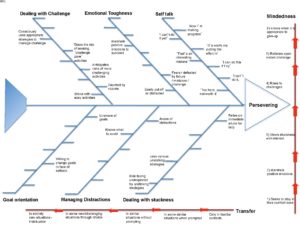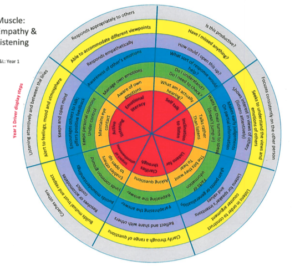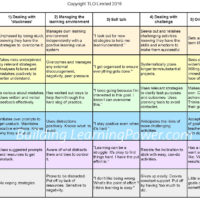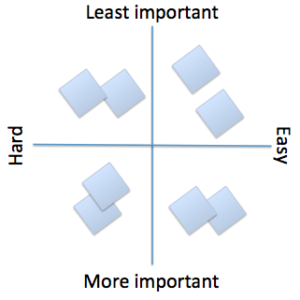Last week we looked briefly at the progression of learning habits and left you with a tricky challenge…..to try to construct a trajectory for perseverance from ‘can’t’ to ‘can do well’. This week we continue this idea and explore our thinking behind mapping the possible progression in learning habits, to answer the question… What does getting better at perseverance look like, sound like, feel like? Read on to find out more.
Why bother?
Some people may ask why we ever bothered to look at progression in learning habits in the first place and sometimes, in the dark times of being really stuck, we did wonder this ourselves. Our interest isn’t rooted in a need to label students as ‘level 3 at keeping going’ or ‘A* at staying motivated’, but rather from a desire to understand the broader, incremental steps that will take a child from, for example, ‘gives up easily’ to ‘confident at tackling challenge’. However, after completing progression maps for one or two learning behaviours we realised that work on progression would also serve to enable teachers to:
- extend the language of learning
- from broad and vague to focused and precise
- deepen understanding of learning behaviours
- their features and scope
- map into the design of the curriculum
- enabling learning behaviours to be developed in a planned and progressive manner across units, terms, years.
- focus task design/lesson planning
- such that tasks/activities might emphasise specific features of the progression
- enable students to set targets for improving their learning behaviours
- feed progression statements into learning-friendly reports for parents
The whole point of building the power to learn is to do just that, to strengthen and enhance students’ learning behaviours; their emotional learning behaviours, their cognitive/thinking behaviours, their social learning behaviours and their ability to manage their learning process itself.
The beginning of this conscious learning journey may start with simply being able to name a learning behaviour and being aware of using it. Sadly, saying it and recognising it doesn’t help you to get better at it and teachers needed more help to move students beyond that simple awareness. What were they helping their students to do, to become? What are the kinds of steps along the way? They needed a map.
Who helped?
In pulling together and researching our progression maps we worked with eight schools from around the country; from north and south, big schools and small schools, primary and secondary, state schools and independent schools. The teachers tried and tested ideas, pulled them apart and put them back together again. It was an generative three year project that captured the development of learning behaviours using a host of different models:




and concentric circles

to single and double ladders…


How did it all end up? The birth of the charts
All this hard work was pulled together, refined, distilled, and gradually re-emerged as progression charts – being the simplest way of displaying various relationships and a wealth of information about how learning behaviours might grow over time. The columns offer the component parts of a learning habit and of course are different in every chart. They show broad categories which combine to make up the attitudes and skills of the behaviour. The rows show the scale of progression showing what learners do as they move from lacking any awareness of the behaviours to where skill and habit blend to become part of a person’s character.
The result is that each cell in the chart contains a statement that describes the sort of skill or attitude a learner at that phase in their journey. will be displaying There’s a long and winding road buried in each statement, and the role of the teacher is to work between the lines to facilitate and nudge students on this journey.
What might the journey look like for perseverance?
Perseverance is key to any learning journey and it’s vital that students are able to get to grips with the knotty emotions of learning, viewing and using them positively as aids to the journey, not as setbacks. Without perseverance little worthwhile learning would ever be achieved.
Perseverance is about the way we stick at things even when they are difficult. What makes us able to persevere more and more usefully? We think several things come into play here. How you are willing and able to deal with being stuck, how you are able to manage distractions and the learning environment wherever that may be, how you relate to a challenge and whether you are influenced by goals, be they your own or imposed by others. All these things contribute how well you are able to persevere. And lastly there’s your own little voice of self awareness: what you say to yourself and how this influences your beliefs, values and actions. This paragraph is translated in to the chart below.
What it looks like in action
Take a look at the descriptions of each chart column to get a deeper view of perseverance.
Dealing with ‘stuckness’
Column 1 is about way how we react when we get stuck; the strategies we have for overcoming it; being brave about not knowing something; how we find ways out of being stuck; how we benefit from feedback about mistakes or being stuck; how we come to realise the value of mistakes, become curious about them and learn from them.
 Managing the learning environment
Managing the learning environment
Column 2 is about how adept we are at maintaining focus; the extent to which we can manage our own learning climate, ignore or manage distractions, regain focus if lost. Students need to be able to manage and take advantage of the learning climate of the classroom. They learn to understand just what distracts them from learning and why distractions can be both a help and a hindrance. How they need to learn to overcome the hard slog of practice and use their environment to help. How the learning environment can include all sorts of negativity from other students and even, occasionally, teachers, and how they might overcome these disruptive emotions. The learning environment itself has many facets that can trip up and stall learning.
 Self-talk
Self-talk
Self-talk is what we say to ourselves as we learn – the little voice of self-awareness. Positive self talk spurs us on. Negative self talk simply destroys learning. The statements capture what someone in each phase of the chart might be thinking. Students may use some of these phrases when talking with you, or in writing from time to time, but mostly self-talk goes on inside their heads. The full progression chart gives a small flavour of self talk thoughts that teachers can encourage students to imitate. Some relate to standards, others to self monitoring, or flexibility. All such positive self-talk is important in building the habit of persevering.
 Dealing with challenge
Dealing with challenge
Column 4 is about how we relate to challenge: are we more excited by the prospect of triumphing over challenge, or more afraid of failing when faced with difficulty? Challenge needs to be included here as part of Perseverance because there is little need to persevere with easy, familiar activities. Students need to be challenged even just for us to discover how or whether or not they persevere at all. So the growth of ways to cope with challenge helps to cement Perseverance. Here they learn to enjoy a challenge, they cope with and learn from making mistakes, and recognise the satisfaction of triumphing over difficulty. The phases include practical ideas like recognising risks, sorting out what the challenge is fundamentally about, and using tools to plan and avoid obstacles.
 Orientation to goals
Orientation to goals
Column 5 concerns goals; having goals can have an impact on our perseverance. Let’s face it, if you haven’t got a goal, or at least an interest in something, you are not likely to stick at it and channel your emotion positively to get it done. In the beginning students have little sense of goals or purpose. Later, students can be helped to understand what a ‘do-able’ goal is and how to turn goals set by the teacher into a goal that they want to achieve – to make it their goal. Later still they learn to put goals into a wider context, to realise that being able to do X or Y isn’t just about the here and now but has wider implications for life. This will certainly come into play when choosing subjects for exams, for example. Do students go for something they like, enjoy and find easy or do they chose some harder options on the basis of their relevance to their future career? This orientation to goals all turns on how we design our own goals, blend these with the goals of others, and then pursue them with tenacity and independence.
Questions
What do you think?
- What have you learned about Perseverance from these descriptions?
- What have you had confirmed?
- What surprised you?
- How have your views changed?
Make a note of…
- Any ideas for practical classroom activities, triggered by these descriptions, that you could use profitably in your classroom.
- Make a note of how you might translate some of the statements into student ‘Can do’ statements or targets.
We think that’s probably enough for this weeks blog! We’ll take a detailed look at the phases of growth next time. But before we go here’s an interesting way in which some secondary schools have used these charts with their students.
The perseverance charts are enlarged, printed onto card and cut up into small cards. Students work in groups of 6 or 7 and first think, talk and sort the cards into what they consider easy to hard. Students then sort the cards into those they think of as important and those they feel are less important. This simple activity has helped students to gain a much richer understanding of perseverance and has surfaced some fascinating discussions. Why not try it with your students?

PS
The perseverance chart is but one of the many progression charts that now help to shape our online courses. Here you will find lots of suggestions of what you might do ‘between the lines‘ to nudge students’ progression in their power to learn.
You can find out more about learning cultures and how to achieve them from our online courses: Stepping Stones Phase 1 (primary) or Nutshells Phase 1 ( secondary)




No comments yet.